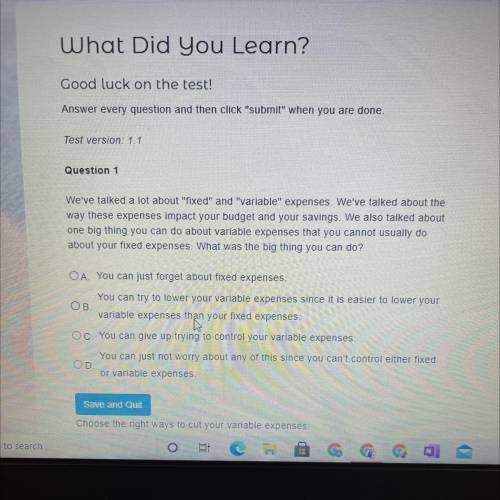
Business, 11.04.2021 05:00 cshopholic4921
We've talked a lot about "fixed" and "variable" expenses. We've talked about the way these expenses impact your budget and your savings. We also talked about one big thing you can do about variable expenses that you cannot usually do about your fixed expenses. What was the big thing you can do?


Answers: 2
Another question on Business

Business, 22.06.2019 02:40
The following accounts are denominated in pesos as of december 31, 2015. for reporting purposes, these amounts need to be stated in u.s. dollars. for each balance, indicate the exchange rate that would be used if a translation is made under the current rate method. then, again for each account, provide the exchange rate that would be necessary if a remeasurement is being made using the temporal method. the company was started in 2000. the buildings were acquired in 2002 and the patents in 2003. (round your answers to 2 decimal places.) exchange rates for 1 peso are as follows: 2000 1 peso = $ 0.28 2002 1 = 0.26 2003 1 = 0.25 january 1, 2015 1 = 0.24 april 1, 2015 1 = 0.23 july 1, 2015 1 = 0.22 october 1, 2015 1 = 0.20 december 31, 2015 1 = 0.16 average for 2015 1 = 0.19
Answers: 3

Business, 22.06.2019 13:50
When used-car dealers signal the quality of a used car with a warranty, a. buyers believe the signal because the cost of a false signal is high b. it is not rational to believe the signal because some used-car dealers are crooked c. the demand for lemons is eliminated d. the price of a lemon rises above the price of a good used car because warranty costs on lemons are greater than warranty costs on good used cars
Answers: 2

Business, 22.06.2019 16:00
In macroeconomics, to study the aggregate means to study blank
Answers: 1

Business, 22.06.2019 19:10
Imagine us is a startup that offers high definition 3d prenatal ultrasounds for high-end customers. the service process includes four activities that are conducted in the sequence described below. (the time required for each activity is shown in parentheses): activity 1: welcome a patient and explain the procedure. (20 minutes)activity 2: prep the patient (e.g., show them to the room, apply ultrasound gel). (17 minutes) (*your id number represents the amount of time needed to complete this task)activity 3: take images. (5 minutes)activity 4: discuss diagnostic with patient. (20 minutes)at each location there are employees (servers) s1, s2, and s3. the assignment of tasks to servers is the following: s1 does activities 1 and 2.s2 does activity 3.s3 does activity 4.a. what is the capacity of this process (in customers per hour)? b. suppose 3 patients arrive every hour on average. ignoring any “start of day” or “end of day” effects, what are the utilizations of all three servers (%)? c. suppose each activity can be done by any server and any server can do any set of activities. however, each activity is done by only one server. for example, a possible assignment includes: s1 does activity 1, s2 does activity 2, and s3 does activities 3 and 4. of course, the original assignment of servers to activities is also feasible. what is the maximum capacity of the process (in customers per hour)? d. now consider the capacity measures in (c) and (a), what is the percentage change? why can you improve capacity without using additional resources? (there is no free lunch, right? )note: for all hw assignments, show your process of getting the results. only providing the final answers is not acceptable and will get 0%. if necessary, use a separate sheet of paper to show your work.
Answers: 3
You know the right answer?
We've talked a lot about "fixed" and "variable" expenses. We've talked about the way these expenses...
Questions







Mathematics, 17.05.2021 17:00

Mathematics, 17.05.2021 17:00


Chemistry, 17.05.2021 17:00

Geography, 17.05.2021 17:00


Mathematics, 17.05.2021 17:00

Social Studies, 17.05.2021 17:00


Social Studies, 17.05.2021 17:00


Mathematics, 17.05.2021 17:00

Mathematics, 17.05.2021 17:00



